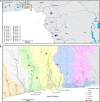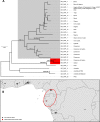Insertion sequence element single nucleotide polymorphism typing provides insights into the population structure and evolution of Mycobacterium ulcerans across Africa
- PMID: 24296504
- PMCID: PMC3911215
- DOI: 10.1128/AEM.02774-13
Insertion sequence element single nucleotide polymorphism typing provides insights into the population structure and evolution of Mycobacterium ulcerans across Africa
Abstract
Buruli ulcer is an indolent, slowly progressing necrotizing disease of the skin caused by infection with Mycobacterium ulcerans. In the present study, we applied a redesigned technique to a vast panel of M. ulcerans disease isolates and clinical samples originating from multiple African disease foci in order to (i) gain fundamental insights into the population structure and evolutionary history of the pathogen and (ii) disentangle the phylogeographic relationships within the genetically conserved cluster of African M. ulcerans. Our analyses identified 23 different African insertion sequence element single nucleotide polymorphism (ISE-SNP) types that dominate in different areas where Buruli ulcer is endemic. These ISE-SNP types appear to be the initial stages of clonal diversification from a common, possibly ancestral ISE-SNP type. ISE-SNP types were found unevenly distributed over the greater West African hydrological drainage basins. Our findings suggest that geographical barriers bordering the basins to some extent prevented bacterial gene flow between basins and that this resulted in independent focal transmission clusters associated with the hydrological drainage areas. Different phylogenetic methods yielded two well-supported sister clades within the African ISE-SNP types. The ISE-SNP types from the "pan-African clade" were found to be widespread throughout Africa, while the ISE-SNP types of the "Gabonese/Cameroonian clade" were much rarer and found in a more restricted area, which suggested that the latter clade evolved more recently. Additionally, the Gabonese/Cameroonian clade was found to form a strongly supported monophyletic group with Papua New Guinean ISE-SNP type 8, which is unrelated to other Southeast Asian ISE-SNP types.
Figures




Similar articles
-
Single nucleotide polymorphisms on the road to strain differentiation in Mycobacterium ulcerans.J Clin Microbiol. 2009 Nov;47(11):3647-52. doi: 10.1128/JCM.00761-09. Epub 2009 Sep 2. J Clin Microbiol. 2009. PMID: 19726608 Free PMC article.
-
Single nucleotide polymorphism typing of Mycobacterium ulcerans reveals focal transmission of buruli ulcer in a highly endemic region of Ghana.PLoS Negl Trop Dis. 2010 Jul 20;4(7):e751. doi: 10.1371/journal.pntd.0000751. PLoS Negl Trop Dis. 2010. PMID: 20652033 Free PMC article.
-
Mycobacterium ulcerans Population Genomics To Inform on the Spread of Buruli Ulcer across Central Africa.mSphere. 2019 Feb 6;4(1):e00472-18. doi: 10.1128/mSphere.00472-18. mSphere. 2019. PMID: 30728280 Free PMC article.
-
The genome, evolution and diversity of Mycobacterium ulcerans.Infect Genet Evol. 2012 Apr;12(3):522-9. doi: 10.1016/j.meegid.2012.01.018. Epub 2012 Jan 28. Infect Genet Evol. 2012. PMID: 22306192 Review.
-
Buruli ulcer: reductive evolution enhances pathogenicity of Mycobacterium ulcerans.Nat Rev Microbiol. 2009 Jan;7(1):50-60. doi: 10.1038/nrmicro2077. Nat Rev Microbiol. 2009. PMID: 19079352 Review.
Cited by
-
Whole genome comparisons suggest random distribution of Mycobacterium ulcerans genotypes in a Buruli ulcer endemic region of Ghana.PLoS Negl Trop Dis. 2015 Mar 31;9(3):e0003681. doi: 10.1371/journal.pntd.0003681. eCollection 2015 Mar. PLoS Negl Trop Dis. 2015. PMID: 25826332 Free PMC article.
-
Spatiotemporal Co-existence of Two Mycobacterium ulcerans Clonal Complexes in the Offin River Valley of Ghana.PLoS Negl Trop Dis. 2016 Jul 19;10(7):e0004856. doi: 10.1371/journal.pntd.0004856. eCollection 2016 Jul. PLoS Negl Trop Dis. 2016. PMID: 27434064 Free PMC article.
-
Topography and land cover of watersheds predicts the distribution of the environmental pathogen Mycobacterium ulcerans in aquatic insects.PLoS Negl Trop Dis. 2014 Nov 6;8(11):e3298. doi: 10.1371/journal.pntd.0003298. eCollection 2014. PLoS Negl Trop Dis. 2014. PMID: 25375173 Free PMC article.
-
Mycobacterium ulcerans ecological dynamics and its association with freshwater ecosystems and aquatic communities: results from a 12-month environmental survey in Cameroon.PLoS Negl Trop Dis. 2014 May 15;8(5):e2879. doi: 10.1371/journal.pntd.0002879. eCollection 2014 May. PLoS Negl Trop Dis. 2014. PMID: 24831924 Free PMC article.
-
Understanding the transmission of Mycobacterium ulcerans: A step towards controlling Buruli ulcer.PLoS Negl Trop Dis. 2021 Aug 26;15(8):e0009678. doi: 10.1371/journal.pntd.0009678. eCollection 2021 Aug. PLoS Negl Trop Dis. 2021. PMID: 34437549 Free PMC article. Review.
References
Publication types
MeSH terms
Substances
Grants and funding
LinkOut - more resources
Full Text Sources
Other Literature Sources

